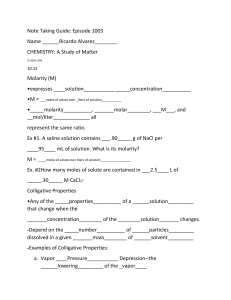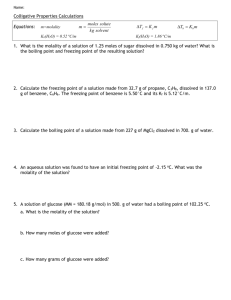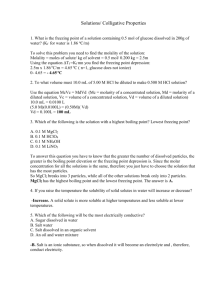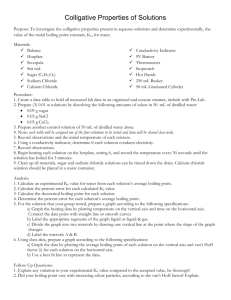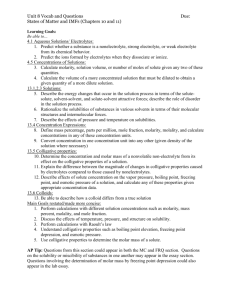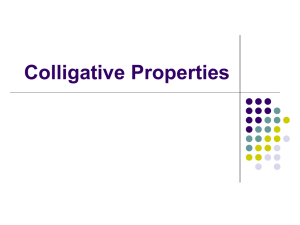Solutions & Colligative Properties Test Review
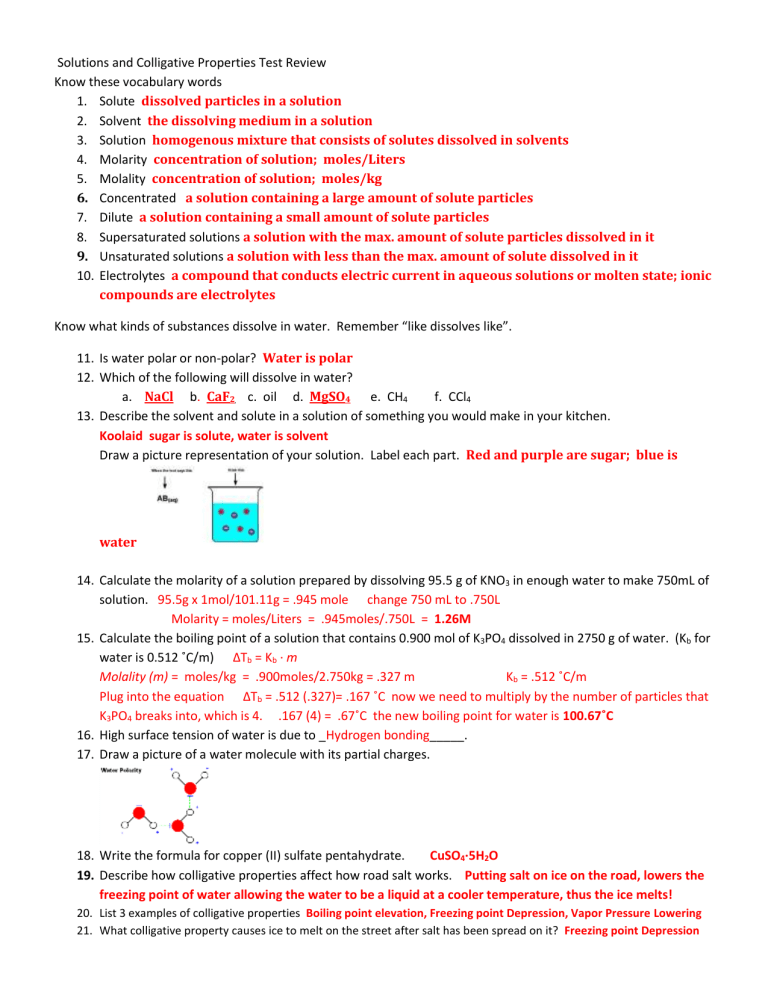
Solutions and Colligative Properties Test Review
Know these vocabulary words
1.
Solute dissolved particles in a solution
2.
Solvent the dissolving medium in a solution
3.
Solution homogenous mixture that consists of solutes dissolved in solvents
4.
Molarity concentration of solution; moles/Liters
5.
Molality concentration of solution; moles/kg
6.
Concentrated a solution containing a large amount of solute particles
7.
Dilute a solution containing a small amount of solute particles
8.
Supersaturated solutions a solution with the max. amount of solute particles dissolved in it
9.
Unsaturated solutions a solution with less than the max. amount of solute dissolved in it
10.
Electrolytes a compound that conducts electric current in aqueous solutions or molten state; ionic compounds are electrolytes
Know what kinds of substances dissolve in water. Remember “like dissolves like”.
11.
Is water polar or non-polar? Water is polar
12.
Which of the following will dissolve in water? a.
NaCl
b .
CaF
2
c. oil d.
MgSO
4 e. CH
4
f. CCl
4
13.
Describe the solvent and solute in a solution of something you would make in your kitchen.
Koolaid sugar is solute, water is solvent
Draw a picture representation of your solution. Label each part. Red and purple are sugar; blue is water
14.
Calculate the molarity of a solution prepared by dissolving 95.5 g of KNO
3
in enough water to make 750mL of solution. 95.5g x 1mol/101.11g = .945 mole change 750 mL to .750L
Molarity = moles/Liters = .945moles/.750L = 1.26M
15.
Calculate the boiling point of a solution that contains 0.900 mol of K
3
PO
4
dissolved in 2750 g of water. (K b
for water is 0.512 ˚C/m) ∆T b
= K b
∙ m
Molality (m) = moles/kg = .900moles/2.750kg = .327 m K b
= .512 ˚C/m
Plug into the equation ∆T b
= .512 (.327)= .167 ˚C now we need to multiply by the number of particles that
K
3
PO
4
breaks into, which is 4. .167 (4) = .67˚C the new boiling point for water is 100.67˚C
16.
High surface tension of water is due to _ Hydrogen bonding _____.
17.
Draw a picture of a water molecule with its partial charges.
18.
Write the formula for copper (II) sulfate pentahydrate. CuSO
4
∙5H
2
O
19.
Describe how colligative properties affect how road salt works. Putting salt on ice on the road, lowers the freezing point of water allowing the water to be a liquid at a cooler temperature, thus the ice melts!
20.
List 3 examples of colligative properties Boiling point elevation, Freezing point Depression, Vapor Pressure Lowering
21.
What colligative property causes ice to melt on the street after salt has been spread on it? Freezing point Depression
22.
What colligative property is responsible for antifreeze keeping water from freezing in a car’s cooling system? Freezing point Depression
23.
What colligative property is responsible for antifreeze keeping water from boiling over during the summer in a car’s cooling system? Boiling point elevation
24.
When a solid is dissolved in a liquid, the vapor pressure of the liquid is _ lowered __ because the surface area from which molecules can evaporate is reduced.
25.
The boiling point of a liquid is the temperature at which its _ external pressure is equal to vapor pressure
26.
How many moles of solute are contained in 2.0L of 3.5M CaCl
2
? 7.0 mol CaCl
2
27.
What is the freezing point of .80m solution of Na
2
SO
4
? K f
for water is 1.86˚C/m -4.46˚C
28.
What is the boiling point of .50m solution of glucose in water? K b
for water is .512˚C/m 100.256 ˚C
29.
Draw the dissolution of 3 moles of NaCl in water.
30.
We have 3 moles of 3 different solutions, rank them from lowest to highest in ability to lower freezing point. Calcium chloride in water, Glucose in water, Sodium chloride in water.
Lowest ability = glucose
Medium ability = sodium chloride
Highest ability = Calcium chloride
